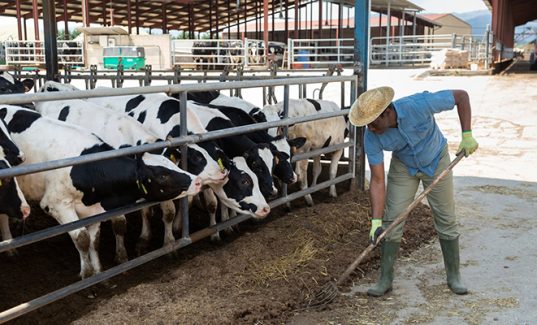Pennsylvania summers are notorious for being hot and humid. People and animals are usually tolerant of the initial on-set of these conditions in June, but it becomes problematic when heat stress is prolonged.
Production perspective
Pennsylvania summers are notorious for being hot and humid. People and animals are usually tolerant of the initial on-set of these conditions in June, but it becomes problematic when heat stress is prolonged. Heat abatement strategies usually focus on the lactating cows, which is justified. However there are other animal groups on the farm susceptible to heat stress and that can result in long lasting consequences.
How is heat stress defined? John Tyson, Ag Engineer with the Extension Dairy Team defines heat stress when rectal temperatures of 8 out of 10 cows are above 102.5° F, or respiration rates in breaths per minute are over 80 per minute or dry matter intake and milk production drop more than 10 percent. To minimize the effects of heat stress there are four basic concepts – SAAW – shade, air exchange, air velocity, and water.
Managing a record keeping system on performance and treatment events in the herd is an excellent way to assess how animals respond to heat stress. The management team at the Penn State dairy barns tracks all events on all animals throughout the year. Examining this information can determine if there are spikes in performance and health problems during the summer. Monitoring this data when heat abatement strategies are implemented can be helpful in determining the payback.
At the Penn State dairy, the lactating cows would experience severe heat stress, especially those housed in the free stall barn. After documenting this summer after summer with up to 20 percent milk loss, 13 percent dry matter intake reduction, and more than four weeks of recovery time, funds were garnered to implement heat abatement strategies. This led to the installation of more fans and a sprinkler system, added water troughs, and feeding brown mid-rib corn silage. All of these changes significantly reduced the degree of heat stress on these animals. The cows maintained production during the summer and if they did experience drops in milk production or intakes, they rebounded much quicker compared to the past.
Depending on where dry cows are housed, they can experience heat stress comparable to the lactating cows. Nutritionists recommend certain additives or nutritional adjustments to help dry cows during these stressful times however the bigger issue is cows eating. If animals are uncomfortable they probably are not consuming the desired amounts of the ration. Intakes are critical during the pre- and post-fresh periods. Health events that spiked in the Penn State dairy during the summer were abortions and fresh cow mastitis and pneumonia. During times when heat and humidity were unbearable, one would observe the dry cows standing right by the fans and there would be very limited activity by the feed bunk. Unfortunately economics plays a large part on what facility changes can be made to help alleviate heat stress. There were no funds available to make adjustments to the dry cow barn but moving fresh cows to a location where they benefited from the fans and sprinklers reduced the incidence of mastitis and pneumonia.
Calves can be susceptible to heat stress. If cows experience difficulty during the calving process, this can carry over to the calf. The added stress of hot weather can result in increased respiratory problems and scours. Proper ventilation, sanitation and nutrition are critical for the pre-weaned calves.
The Extension Dairy Team conducts a webinar series and the archived presentations can be found on the Technology Tuesdays course page. Presentations cover heat abatement strategies as well as other engineering recommendations to improve cow comfort during these stressful times.
Action plan for sampling forages
Goal: Develop and utilize a monitoring tool for evaluating heat stress on animal performance.
Step 1: Using Excel or purchasing the appropriate dairy software, track milk production, dry matter intakes, treatment events, and health indicators for all animal groups.
Step 2: Review data on a monthly basis during the summer. Implement management changes to help alleviate problems that are being detected. Continue monitoring to evaluate if new protocols are working.
Step 3: If problems persist, contact a specialist to examine facility changes or enhancements that would benefit the cows during the summer months. Develop a partial budget to evaluate the expected improvements in animal performance and the payback on costs for any proposed changes.
Economic perspective
Monitoring must include an economic component to determine if a managementent strategy is working or not. For the lactating cows income over feed costs is a good way to check that feed costs are in line for the level of milk production. Starting with July’s milk price, income over feed costs was calculated using average intake and production for the last six years from the Penn State dairy herd. The ration contained 63% forage consisting of corn silage, haylage and hay. The concentrate portion included corn grain, candy meal, sugar, canola meal, roasted soybeans, Optigen® and a mineral vitamin mix. All market prices were used.
Also included are the feed costs for dry cows, springing heifers, pregnant heifers and growing heifers. The rations reflect what has been fed to these animal groups at the Penn State dairy herd for the past 6 years. All market prices were used.
Source – AGWeb




